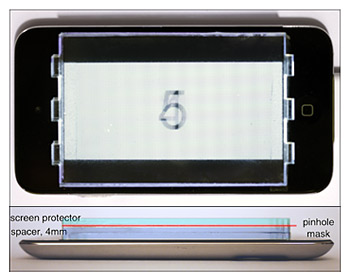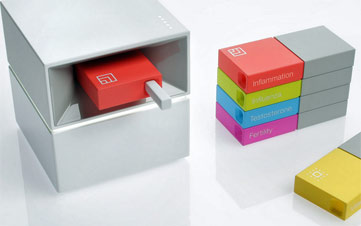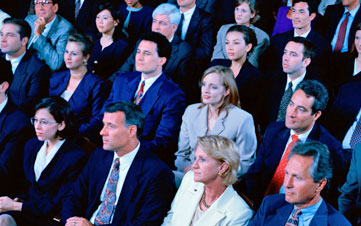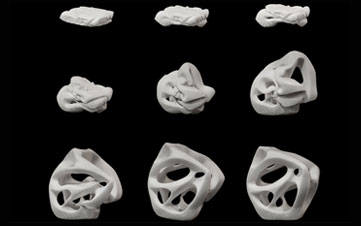9 Amazing New Technologies That Will Change Your World
For 91 years, subscribers have relied on The Kiplinger Letter for insights into emerging technologies that will change the way Americans live and do business.


For 91 years, subscribers have relied on The Kiplinger Letter for insights into emerging technologies that will change the way Americans live and do business. Examples of "you read it first in Kiplinger" include the rise of commercial air routes in 1927, the early development of television in the 1930s, electronic office machines in 1953 and “smartphones” in 1979.
Now on the horizon: controlling your computer, or other devices, with only your thoughts. Furniture that assembles itself. And medical testing at home that could save you a trip to the doctor. Take a look.

Crystal-Clear Screens, No Glasses Required
Recent advances in computer software make images that would otherwise be blurry appear clear to folks with vision impairments including nearsightedness, farsightedness and astigmatism.
Researchers at the University of California, Berkeley, working with backing from the National Science Foundation, have developed a prototype that works with a special sheet of plastic mounted over a computer screen and software that adjusts the picture to users' specific needs, so that they can watch without glasses or contacts.
They even anticipate the ability to adjust for multiple viewers, so that grandma and grandson could watch the same screen despite having completely different prescriptions. But the first place where this technology will be adopted is the workplace, since 60% of Americans need corrective lenses, and computers are the top cause of vision complaints at work.

Thought Control
No, we’re not talking about controlling other people’s thoughts (though folks are still working on that). But you can control devices with brain waves, picked up via EEG sensors. Already, the technology can be harnessed to pilot a toy plane, control action in a video game, and make prosthetic devices move.
Laboratory devices with scalp-mounted sensors now cost tens of thousands of dollars or more. But cheap, reliable headsets are coming. In fact, NeuroSky offers an EEG headset and video games you can play with it for $200.
Clinicians are seeing promising results for patients with hyperactive disorder, post-traumatic stress, anxiety and sleep disorders by letting them see in real time whether treatments like meditation are working effectively. Another potential user base: truck drivers and others who operate heavy machinery where fatigue is a risk. The headsets could send an alert to a smartphone or other device when brain activity falls below a certain level.

Bringing the Doctor Home
The next phase of health monitoring? At-home tests that take minutes. Health gizmos will tell whether you have the flu, need vitamin D, or have low testosterone. Small versions will use advances in microfluidics and biosensors to spit out readings on the molecular level, giving users detailed analysis of blood, saliva or nose swabs.
The devices will gain popularity with the elderly, athletes and people with chronic diseases. One device, called Cue, will cost a few hundred dollars and test for fertility, testosterone, influenza, vitamin D or inflammation through blood, saliva or nasal samples. Each test will cost about $4.
Though a range of health diagnostics will see strong growth in coming years, doctors will be concerned about patients drawing incorrect conclusions from tests. Many services will also provide oversight from doctors and other health professionals via videoconferencing.

Holograms, at Last
You probably have a hologram in your pocket — it’s that little security feature on your credit card, the one with the prismatic colors. But a new leap forward for these three-dimensional images is coming in the next three to five years: Your tablet, smartphone or similar device will be able to project them.
Being able to manipulate an image in three dimensions will have practical business applications for remote mechanical and medical work. Think of a worker on an oil & gas drilling rig manipulating a robot arm from a safe distance, or a doctor looking at a 3-D image of a heart to consult at a surgery being performed thousands of miles away. In the office setting, holograms will make video conferences much more realistic. At home, more helpful online shopping.

HVAC With a Brain
Thanks to new sensors and connectivity, heating and cooling systems will see advances that will make the much-ballyhooed Nest thermostat look like an old Honeywell dial. For instance, with facial recognition cameras, HVAC systems will be able to know how many people are in a room and adjust accordingly. (Each human adds roughly as much heat as a 60-watt incandescent light bulb.)
In larger buildings, systems will use weather forecasts — for example, anticipating a heat wave and precooling a building at night, when electric rates are lower. LED lighting systems will automatically adjust to sunlight and time of day so that rooms aren’t over- or underlit. And windows will filter out sunlight automatically with LCD glass.

Supertight Inventory
Retailers have made much use of electronic tags to track inventory and reduce losses, but the technology is about to take a leap forward.
For stores, the tumbling price of small radio-frequency ID devices (down to as little as a nickel each) means that even small businesses can take advantage. And the cumbersome handheld scanners now used will go away, as stores add hundreds of antennas in the ceiling to track each item’s location. Stores will know if shoppers aren’t touching certain items, so that a discount can be automatically added to a computer system if an item is catching dust. And if an item is picked up, it could be made unavailable for online sale for a certain period of time to avoid duplicate sales. This feature would be of most interest to luxury retailers keeping a very close eye on their pricey inventory.
Out in the loading dock and in warehouses, sensors will monitor temperature, humidity, pressure, light exposure and more. The continuous monitoring data will be sent wirelessly via a cellular network. It will be useful for expensive or sensitive items shipped via plane, such as pharmaceuticals, auto parts and high-end art. Sellers of emerging systems, including FedEx and AT&T, hope to garner interest among firms with complicated supply chains.

Catching Power From the Sky
As people wearing tinfoil hats can tell you, the air around us is full of signals. In the future, we’ll be able to capture some of that energy — in the form of Wi-Fi signals, vibration, heat and sound — and convert it to usable electric power. The principle here is as old as the very first radios, which ran on nothing but the power that came from the transmitter tower, but changes in materials have made it more efficient.
Early applications will be for low-power sensors in remote locations that can collect power all day long, then send out information about what they’re monitoring (temperature, location, structural integrity) in a quick burst once they’ve accumulated enough power. Highway departments could get updates on sensors mounted all over bridges, checking for sag and other defects, without the need to replace batteries or rely on access to daylight for solar power.
But the idea of finding power in the air for consumer devices such as mobile phones is the Holy Grail for vendors of this equipment. Currently, power demands of phones and the like are too high, and the amount of energy that can currently be captured is too low.

No More "Some Assembly Required"
Frustrated by putting together flat-pack furniture (you know, like from that big Swedish company)? Imagine furniture that assembles itself, with pieces that can attach through magnets or through tension (elastic cords, for example). It can be boxed up, then assembled with minimal effort from the new owner, who might only have to toss it on the floor or flip it around.
Another nascent technology from Belgian designer Carl de Smet would allow a flat piece of foam to become a chair, once plugged into an electric outlet so that heating elements buried inside would activate the polymers to take shape.
More shape-shifting elements could be found on your feet: shoes that have flat soles for walking on paved surfaces but pop out cleats when you run on grass.
Profit and prosper with the best of Kiplinger's advice on investing, taxes, retirement, personal finance and much more. Delivered daily. Enter your email in the box and click Sign Me Up.

John Miley is a Senior Associate Editor at The Kiplinger Letter. He mainly covers AI, technology, telecom and education, but will jump on other business topics as needed. In his role, he provides timely forecasts about emerging technologies, business trends and government regulations. He also edits stories for the weekly publication and has written and edited email newsletters.
He holds a BA from Bates College and a master’s degree in magazine journalism from Northwestern University, where he specialized in business reporting. An avid runner and a former decathlete, he has written about fitness and competed in triathlons.
-
 Forget FIRE: Why ‘FILE’ Is the Smarter Move for Child-Free DINKs
Forget FIRE: Why ‘FILE’ Is the Smarter Move for Child-Free DINKsHow shifting from "Retiring Early" to "Living Early" allows child-free adults to enjoy their wealth while they’re still young enough to use it.
-
 7 Tax Blunders to Avoid in Your First Year of Retirement
7 Tax Blunders to Avoid in Your First Year of RetirementA business-as-usual approach to taxes in the first year of retirement can lead to silly trip-ups that erode your nest egg. Here are seven common goofs to avoid.
-
 How to Plan for Social Security in 2026's Changing Landscape
How to Plan for Social Security in 2026's Changing LandscapeNot understanding how the upcoming changes in 2026 might affect you could put your financial security in retirement at risk. This is what you need to know.
-
 What Is AI? Artificial Intelligence 101
What Is AI? Artificial Intelligence 101Artificial intelligence has sparked huge excitement among investors and businesses, but what exactly does the term mean?
-
 Text-Generating AI Faces Major Legal Risks: Kiplinger Economic Forecasts
Text-Generating AI Faces Major Legal Risks: Kiplinger Economic ForecastsEconomic Forecasts Major legal risks to text-generating artificial intelligence: Kiplinger Economic Forecasts
-
 32 Ways to Make Money in 2025
32 Ways to Make Money in 2025business Check out these cool side hustles to earn bonus bucks this year.
-
 12 IRS Audit Red Flags for the Self-Employed
12 IRS Audit Red Flags for the Self-Employedtaxes If you are self-employed, minimize the odds of an IRS audit by avoiding these audit triggers.
-
 Business Cost Outlooks for 2022: Eight Key Sectors
Business Cost Outlooks for 2022: Eight Key SectorsEconomic Forecasts What’s in store for all sorts of business costs in 2022?
-
 PPP Loan Basics for Small Business Owners
PPP Loan Basics for Small Business OwnersCoronavirus and Your Money Although uncertainty and confusion have surrounded the Paycheck Protection Program since its launch, that shouldn't stop small business owners from participating in the loan program, which was just extended to May 31.
-
 Add a VPN to Surf the Internet Safely
Add a VPN to Surf the Internet SafelyTechnology To help you fight identity theft, consider adding a VPN.
-
 "Above-the-Line" Deductions for Your 2021 Tax Return
"Above-the-Line" Deductions for Your 2021 Tax ReturnTax Breaks If, like most people, you claim the standard deduction instead of itemized deductions on your return, there are still many other tax deductions available that could save you a lot of money.
